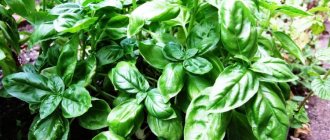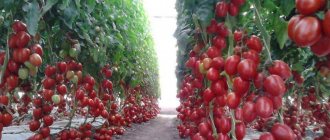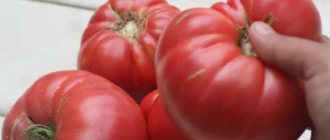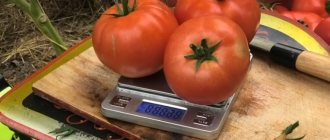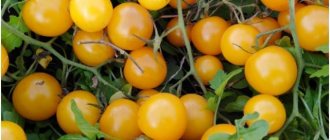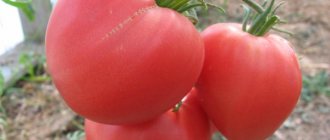Good afternoon, my reader. Many breeder manufacturers promise various miracles and incredible yields when offering their products. But are all hybrids as “wonderful” as they promise us? Is it true that tomatoes can be grown on potato plants, are there apple-flavored tomatoes and other incredible hybrids?
Tomatoes. The illustration for the article is used under the standard license ©ofazende.com
First, let's figure out what a hybrid is. This term refers to organisms that are obtained by crossing different genetic forms. Plants are crossed in different ways:
- Manual method (pollination, removal of panicles).
- Using chemistry (gameticide).
- Genetic methods (self-incompatibility, male sterility).
You can cross plants of the same species and make hybrids by mixing different species. But everything happens within one kingdom - plants. That is, you can cross carrots with potatoes, but this method will not work with mushrooms or rabbits.
But there are plant specimens that are called chimeras. Such hybrids are created under scientific experimental conditions, they are treated with mutagens, chemicals, physical crossing and other sophisticated influences are carried out.
IMPORTANT! All properties of chimeras are preserved only during vegetative propagation; seeds cannot be obtained from them; they grow only for one season.
Now let's move on to the most interesting hybrid tomatoes that are available for sale.
Potato tomatoes (tomatoes + potatoes)
British scientists developed this miracle hybrid. On top of the plant are tomato tops and juicy tomatoes; potato tubers grow in the soil. In English it is called Tomtato, in Russian it can be loosely translated as Pomidofel.
Up to 500 cherry tomatoes are formed on top of the hybrid, and white potato tubers are formed below, which can be boiled and fried.
Potato tomatoes. The illustration for the article is used from the site stroyka.radiomoon.ru
In fact, Pomidofel is nothing out of the ordinary. Potatoes and tomatoes belong to the same nightshade genus, so scientists did the usual grafting of cherry tomatoes onto potatoes. The parts of the plants grow together to form a single whole, and then you supposedly get two incredible harvests.
Open ground tomatoes
This group is characterized by increased resistance to natural deviations (high temperature, wind, short-term return frosts, high humidity, etc.). They have good shelf life and can be grown for sale. The most popular of them:
- “Sibirskaya Troika” is a variety of Russian selection. Designed for cultivation in difficult weather conditions (Siberia, Ural, etc.). The stem is standard (60 cm). Therefore, it does not require gartering or pinching. The fruits are large (up to 300g), pepper-shaped, with excellent taste.
- “Kibitz” is a variety of Polish selection from 2006. Ultra early. The crop ripens several times per season. The fruit is not large (60-80g), elongated, good for canning. Resistant to wind and late blight, does not form stepsons.
- "Belle F1" is a hybrid of Dutch selection. Tall, will require a mandatory garter. It tolerates shady places, temperature changes and tomato diseases. The fruit is dense, smooth, weighing 200 grams. Very tasty.
- "Bobcat F1" is an excellent hybrid that consistently produces high yields. The fruits are smooth, bright red, weighing 250-300 grams with an ideal taste, very aromatic with granular pulp. Do not crack.
- “Pink Flamingo” is an early ripening variety. The fruits are large (up to 300 g) with a spout, a real pink color. They do not crack and are well stored fresh (up to 2 months). The taste characteristics are excellent. The downside of the variety is its tendency to blossom end rot.
It is worth paying attention to the following representatives of this group: Duchess F1, Gulliver, My Love F1, Zastolny, Elena F1, Champion F1, Prokhor F1, Hero of Early F1, Apricot F1, etc.
Apple tomatoes (tomatoes + apples)
Swiss gardener Kobert has been doing strange things for the last 20 years - growing vegetables that look like apples on the outside, but are tomatoes inside. This fruit and vegetable is called Redlove.
But this is not the result of crossing an apple and a tomato. This fruit has nothing to do with tomatoes; these are red-fleshed apples. That is, they grow on apple trees, but they just have a different taste from apples. Michurin developed similar varieties a long time ago.
Apple tomatoes. The illustration for the article is used from the site unnw.ru
Features of choosing hybrid seeds
A hybrid is obtained by crossing two varieties that have some desired qualities. For example, one variety is characterized by high yields, but cannot resist diseases. The other has immunity against diseases, but the number of tomatoes harvested per season is much less. The hybrid has a number of advantages:
- the seeds sprout together;
- less demanding on growing conditions;
- more resistant to diseases;
- has improved taste compared to pre-hybridization;
- The yield is much higher, the fruits are even.
The second generation hybrid will not give the same results as in the first year of cultivation. Therefore, seeds will have to be purchased every year.
Before choosing the desired variety of tomatoes, you need to know their main characteristics. And also remember that it is better to grow varieties and hybrids acclimatized in a given area. Therefore, plants created by Russian breeders are suitable.
Productivity obtained by selection
It may not be strange, but the yield of tomatoes in a greenhouse depends on weather conditions. The more sunny days, the faster the fruits ripen. And also from good agricultural technology. With the right approach and good weather conditions, you can collect up to 10 kg of fruit from one bush, and half as much in open ground. But each variety has its own yield. So the hybrid Sumochka is about 16 kg per square meter, and Evpatoriya is up to 40 kg. Russian size – 10 kg. You can increase productivity in the following simple ways:
- From each cluster of determinate varieties you need to cut several green fruits. Then the remaining fruits will be larger;
- You can place buckets of manure around the perimeter of the greenhouse. The concentration of carbon dioxide increases, and tomatoes grow faster.
Productivity cannot be increased by uncontrolled application of mineral fertilizers.
Bush type
Determinant. Or limited in growth. The growth of the central stem ends with a flower cluster and the movement of the strongest lateral shoot begins. These are hybrids such as Volgograd, Cavalcade and others.
Indeterminate. Not limited in growth. That is, you will have to pinch the top of the bush at the desired height. Example: Krasnobay, Gilgal, Ural, Typhoon F1.
Main types of bushes
Depending on the power of the plant, it is formed from one to three stems.
Tomato ripening speed
Greenhouse tomatoes are divided into early, medium and late ripening. The days from planting seedlings to harvesting the first harvest are taken into account:
- early ripening (90 - 95 days). Cavalcade, Evpatorius, Agatha, Aphrodite;
- mid-season (100 – 110 days). Krasnobay, Sibiryak, Miracle of the Earth;
- late ripening (from 115 days). Ural, Volgograd, Russian size, Snowfall;
Volgogradsky is mid-season and bears fruit after 110 days
Disease resistance
Hybrid plants resist diseases better than varietal tomatoes. Resistant to fusarium, cladosporiosis, tobacco mosaic.
Manifestation of cladosporiosis of leaves
You cannot rely on this feature of hybrid tomatoes. Disease prevention measures will protect against crop loss.
Storage duration
Late-ripening varieties are stored for a long time. Gardeners collect them at the stage of milk maturity. The fruits lie for some time in a dark place and at room temperature (7-20 degrees), ripening to the desired condition. But these tomatoes have a peculiarity - they have rough skin and the taste is slightly lost. Typically, the raceme varieties are stored better. Until the New Year, the fruits of the hybrids Long Keeper, Sochelnik, Zazimok, and Red Stone may lie.
Lemon tomatoes (lemon + tomato)
Israeli scientists claim that they are the only ones in the world who managed to develop lemon tomatoes, and even with the scent of roses. The fruits turned out to be a delicate pink color, because they contain less lycopene than standard fruits. Horticultural scientists have also found that these tomatoes are stored better and longer than conventional varietal ones. Israeli scientists are not going to stop there; they want to add other varieties with original tastes and aromas to Lemato.
There are several questionable details in this story:
- How can you cross a lemon from the Rutaceae family and a tomato from the Solanaceae family?
- How can a smell or color indicate that a genetically new plant has been bred?
Lemon tomatoes.
The illustration for the article is used from the site semenaorg.ru Lemato also costs a lot of money. Since it is stated that unique genetic developments and innovations were used to breed the vegetable. But which ones are not specifically stated anywhere.
Photo gallery
Intuition F1 - one of the best tomato hybrids for picking with trusses, mid-season, from germination to harvesting the first fruits - 110 days. Growth is indeterminate (vigorous), the first inflorescence appears after the 9th - 10th leaf, a cluster of 6-8 fruits, equal in size, round, beautiful, with a shiny bright red skin. The base of the brush is strong, there are practically no creases. The fruits weigh 100-110 g, do not crack or fall off. They are well transported and stored for a long time.
Blagovest F1 is one of the most popular and very tasty tomato hybrids; it is classified as mid-season: 105 days from germination to the start of fruiting. Recommended for growing in winter-spring rotation of winter and film greenhouses, medium-sized plant, weakly leafy. The first inflorescence is laid above the 7-9th leaf, and subsequent ones - after 1-2 leaves. Fruits weighing up to 100 g, smooth, round, bright red in color.
La la fa F1 is a mid-season hybrid, from germination to fruiting - 105-115 days, characterized by a unique combination of characteristics of productivity, early ripening, large-fruited, excellent quality and good keeping quality. Recommended for growing in spring-summer rotation and in film greenhouses, this tomato hybrid is low-growing (70 cm), heavily leafy, 2-3 inflorescences are formed on the main shoot, and further shoot growth continues due to one of the upper lateral shoots.
Attention! It must be remembered that the plant quickly stops growing and does not resume until the ripening and harvesting of fruits begins.
The leaves are large, slightly dissected, dark green, the internodes are shortened. The first inflorescence is laid above the 8-9th leaf, the subsequent ones - after 1-2 leaves. The brush does not break, there are 4-5 compactly located fruits on it. The fruits are large, 140-160 g, round, the color when fully ripe is deep bright red, they do not crack or fall off. Ripe fruits of the La La Fa tomato hybrid, grown in a greenhouse, can be stored under normal conditions for up to one and a half months without losing their qualities.
Vladimir F1 is one of the best mid-season tomato hybrids for greenhouses, fast-growing, vigorous, well-leafed. The first inflorescence is laid above the 10-12th leaf, the brush is not broken, instead of the first flower a small leaf is laid, which indicates the unique keeping quality of mature fruits for 5-7 weeks. The fruits are round, weighing 120-130 g, bright red.
Cyphomandra (tree tomatoes)
Many people mistakenly consider the tsifomandra to be a tomato, but they are only related to the nightshade family. This tropical plant can be grown at home in a pot, its fruits are indeed similar to tomatoes, but do not be fooled, this is not a miracle of selection, but a separate vegetable. The taste of the fruits is slightly reminiscent of unripe tomatoes, but overall it is neutral.
Tree tomatoes. The illustration for the article is used from the site ogorod.mirtesen.ru
Indoor tomatoes
This group is distinguished primarily by self-pollination. Therefore, it mainly includes hybrids, but there are also varieties. Vegetable growers prefer to plant tall plants in greenhouses that produce large or small fruits, but in large quantities, wanting to fully utilize the protected area.
However, there are new short hybrids that are not inferior to their tall counterparts.
Salad tomatoes for growing in a greenhouse: Geisha F1, Fairy Gift F1, Andromeda F1, Eagle Beak F1, Pink Pearl F1, Scarlet Caravel F1, Fatalist F1, Aphrodite F1, Zemba F1 and many others.
Tomatoes for canning: Pink Hype F1, Banana Legs F1, Pink Raisins F1, Raja F1, Alexander the Great, Baba and others.
Unusual varieties obtained without crossing
Sometimes gardeners mistakenly consider some varieties to be hybrids obtained by crossing different vegetable crops. But in fact, these are unusual varieties of tomatoes without other impurities:
- Blueberry-Indigo - this variety was developed by American breeders; the fruits have a rich dark purple color, the bush grows up to two meters.
- Cafe Blue is another American variety, quite rare. The fruits are shaped like pears and have a sweet taste, so some sources mistakenly write about their crossing with pears.
- Grapefruit - when cut, these tomatoes really resemble citrus. They have red and juicy flesh and a bright orange color. But no grapefruits were also involved in the development of this variety.
Classifier of varieties and hybrids
The culture is highly flexible to selection. In this regard, a huge number of varieties and hybrids have been developed that meet the required characteristics.
The choice of variety always depends on the gardener - his taste preferences, plans for further harvesting of tomatoes, and the growing conditions that he can create for future specimens.
It is difficult to navigate such diversity, but it is possible to build a certain algorithm by which to subsequently determine the necessary varieties or hybrids.
There are distinct groups that combine tomatoes with certain characteristics. Even agricultural manufacturing companies adhere to this classifier, which further facilitates the search for vegetable growers.
Photo gallery
It has high taste qualities. Good marketability and transportability. The hybrid is resistant to viruses, fusarium, cladosporiosis, and verticillium. It is recommended to grow in two rotations (spring and summer-autumn).
F1 Magnus is an early ripening hybrid, from germination to ripening - 90-100 days. The fruits are round, red, dense, transportable, weighing 140-160 g, and ripen smoothly. The hybrid is resistant to a range of diseases and root-knot nematodes. When treated with growth regulators, a “spout” is formed on the fruits. Productivity over 16 kg per 1 sq. m.
F1 Semko 99 is a mid-early hybrid, from full germination to ripening - 100-105 days. The fruits are red, flat-round in shape, weighing up to 170 g. The fruits are resistant to cracking and transportable. These hybrid tomatoes for greenhouses are resistant to root-knot nematodes, tobacco and cucumber mosaic viruses, fusarium, verticillium and tolerant (resistant) to late blight. Tolerates thickening (3 plants per 1 sq. m). Stable in yield for ten years.
F1 Partner Semko is a mid-early hybrid, from germination to ripening - 105-110 days. The fruit is flat-round, dense, weighing 180-200 g, ribbed, red. The taste is good. Resistant to cracking, transportable, stored for a month. The hybrid is resistant to many diseases and tolerant to late blight. Productivity up to 18 kg per 1 sq. m.
F1 Chimgan - medium early (105-110 days). The fruit is round, dense, red, slightly ribbed, weighing 220-280 g. Resistant to cracking, viral and other diseases, transportable. Able to be stored for 2-3 weeks, productive.
Tomatoes that do not require pinching
Having planted seeds in the soil, gardeners immediately think about how the green leaves will take up useful elements during the growth process. To prevent this from happening, the stepsons are removed - this is the rule that gardeners adhere to. But there are types of tomatoes that do not need this.
Favorite 6 F1
The main feature is the low ability to form shoots on bushes. The favorite has good resistance to temperature changes, but it is better to grow it in a greenhouse.
Red Arrow F1
The fruits ripen early, the average size of a tomato is 100 grams. The height of the bush is 120 centimeters, up to 10 brushes are formed on it.
Gunin F1
The fruits of this plant contain a large amount of useful substances. The hybrid has a short growing season; the first tomatoes on the bushes ripen after 100 days.
Galaxy F1
Gardeners are not familiar with the appearance of this plant. The bushes bear fruit well, have an interesting taste and high yield.
Semi-determinate hybrid tomatoes for greenhouses
The group of semi-determinate hybrid tomatoes includes plants with a height of 150-160 cm, which require support or tension of a trellis for tying, since they are formed mainly into one stem.
F1 Chirchik is a mid-early hybrid, from germination to ripening - 100-110 days.
Look at the photo - the fruits of this tomato hybrid are round, dense, red, slightly ribbed, weighing 200-250 g:
The most productive hybrids of the latest foreign tomatoes for greenhouses
Currently, quite a lot of vegetable seeds are on sale, which are resistant to a range of diseases, early, abundant and long-term fruiting. These seeds are produced by both domestic and foreign breeding stations. It is quite difficult to find in this huge world what is acceptable for a personal plot. Such variety can make your eyes wide open, and the choice may be made incorrectly. Therefore, first, familiarize yourself with the latest tomato hybrids for greenhouses of foreign selection, already tested by local gardeners and appreciated by them.
Silhouette F1 is a super early semi-determinate tomato hybrid (150-180 cm) for film greenhouses and shelters for spring rotation. For 1 sq. m 3 plants are planted. Hybrid Silhouette has a powerful root system. It is better to grow these tomatoes in two stems. When planting seedlings of this hybrid at the age of 45-60 days in a film greenhouse, the harvest can actually be obtained in 55 days. Even under unfavorable weather conditions, the hybrid ties at least 6 tassels. The fruits are beautifully colored, without a green spot at the stalk, weighing 130-150 g, slightly flattened, leveled, dense, tasty. Silhouette fruits are well stored (up to 1.5-2 months) and transported. This one of the best tomato hybrids for greenhouses is resistant to many diseases, but it still needs to be provided with preventive measures and good care.
Yvette F1 is a semi-determinate hybrid for spring-summer cultivation in film greenhouses and nurseries; it also works well in the second rotation of a winter greenhouse.
Hybrid Yvette is a plant with shorter internodes than Silhouette. It sets fruit well, has a strong stalk, so there is no “breaking” of the brush.
As you can see in the photo, this tomato hybrid has large (140 g), red, shiny, round fruits:


